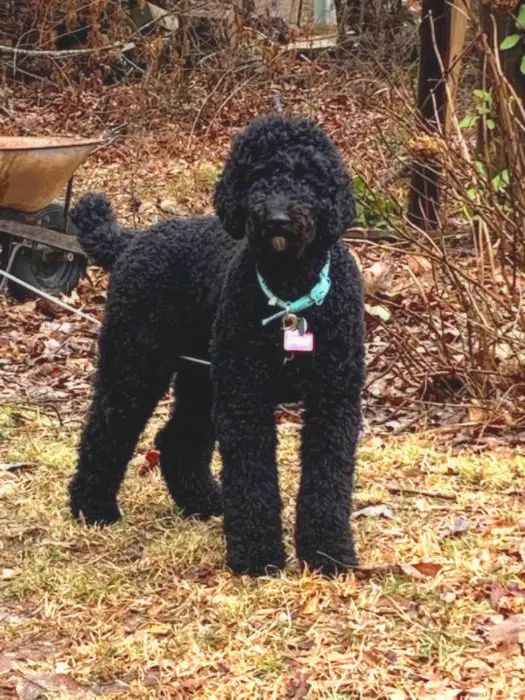Labradoodles, or a hybrid between a Poodle and a Labrador Retriever, are incredibly popular because of their thick curls and friendly nature. But a lot of people may need a family dog that can double as a good guard or watchdog. But are Labradoodles protective?

Labradoodles are not naturally good guard dogs and are not likely to aggressively protect an owner if they are threatened or attacked. However, Labradoodles can be vocal dogs which may make them good watchdogs, and the larger ones look quite threatening due to their thick fur. Their loud and imposing bark may also scare away potential threats.
How does genetics play a role in the protective nature of a Labradoodle? And can environmental conditions make them better guard dogs?
Differences Between Guard and Watchdogs
Before understanding whether or not the Labradoodle is a great guard dog or watchdog, it’s important to understand the difference between those terms.
What is a Watch Dog?
When talking about Labradoodles as watchdogs, you would be talking about a constantly alert dog. Or one that is very perceptive. The caveat is that these dogs are often very vocal and territorial.
If there is something a watchdog perceives to be a threat, they will notify you with a few loud barks.
What is a Guard Dog?
Guard dogs are very similar to watchdogs. This may be the reason why they are often confused with one another, or seen as the same thing.
The difference between the two is that a watchdog’s job stops after they have notified their owner of the threat. They will do nothing further.
A guard dog, on the other hand, will protect their owner if it is required, often by attacking what they think is dangerous.
Are Labradoodles Genetically Suited To Be Watch or Guard Dogs?

The Labradoodle is created by crossing a purebred Poodle and a purebred Labrador Retriever. Both of these dogs were actively used in hunting.
The Poodle was initially bred to retrieve waterfowl, while the Labrador Retriever would – as the name suggests – was bred for similar conditions where retrieval was required.
Neither of these had to be particularly aggressive. In fact, a gentle nature that prevents the dog from damaging the animal it is retrieving with its teeth would have been sought after.
Labradoodles Are Not Genetically Protective
Because neither the Poodle nor the Labrador Retriever needed to be protective in any way and actually needed to work well with other people and dogs, the Labradoodle has no genetic protectiveness or aggression.
Why Labradoodles Are Not Good Guard Dogs
Labradoodles Are Friendly
Labradoodles are extremely friendly and sociable most of the time. They are rarely skittish when it comes to meeting new people and dogs. Especially if they have been socialized adequately when young.
This means that they are more likely to run up to lick an intruder to death than physically attack them.
Labradoodles Are Gentle
Labradoodles have been known to have a surprisingly gentle nature considering their size. They are quite energetic but rarely violent and know how to play ‘softly’.
Why Labradoodles Might Be Good Watchdogs

Even though they have no genetic predisposition to being guards or watchdogs, there are many characteristics that may make your Labradoodle suitable for being a watchdog specifically.
Labradoodles Are Vocal and Territorial
Labradoodles can be extremely vocal and territorial. This means that, when someone approaches your home, they will start barking.
This may not be the case if the Labradoodle is not in its home. If you require a watchdog when you are out walking late in the evening, it is important to note that their territorial instincts may not kick in.
Labradoodles Can Be Big
Labradoodles, especially those bred from Standard Poodles, can be rather big. On the larger end, they may hit 90 pounds (40kg). The result is that they can be incredibly intimidating, especially to those who are not familiar with the breed and their friendly nature.
This also makes their barks even more terrifying.
Thick Fur

Their thick fur makes the Labradoodle seem even bigger than they actually are. On top of this, it may hide their facial features, making them seem more intimidating.
Trainable
Labradoodles are very easy to train and find great pleasure in following their owners’ commands. This means that, for the most part, you should find it relatively easy to train certain commands that prove beneficial to you.
Keep in mind that a couple of tricks have nothing to do with aggression.
Socialization and Aggression
In my experience, socialization can have a major effect on how aggressive your Labradoodle is. Your Labradoodle will be less likely to be vocal and aggressive in certain situations if they are socialized from a young age. If you want a guard or watchdog, this can work for and against you.
Ideally, most people want to have as much control over their dog as possible. This means that the dog will listen to commands you have taught it regardless of what is happening around it. Your Labradoodle will also be more confident in new situations.
However, if your Labradoodle is more cautious, it will be more prone to aggression. This difference is unlikely to be large enough that they become protective unless you are actively harmed already. But, it may induce growling and snarling.
Not socializing your dog in order to make them a better guard dog is, however, not recommended. An unsocialized dog can be very difficult to control and may wreak havoc in your home.
Previous Experiences and Protectiveness
The previous experience of a Labradoodle can play an even bigger role in how protective they are than their genetics. Socialization is just one factor of their past that may play a role.
This may not be something that you can consider if you want to get a Labradoodle puppy. However, if you are adopting one from a shelter, ask about the past of the Labradoodle. This may give you some indication that it will be protective.
Training Guard Dogs

Labradoodles will likely never be trained as attack dogs. They need to be more suitable for it. However, there are some things that you may be able to train into your dogs that will help them protect you if you are threatened or simply be better watchdogs.
Speak on Command
Speaking on command can be a great way to train your highly intelligent Labradoodle to protect yourself. As mentioned above, they are naturally vocal, and their size can make their barks seem very threatening.
Teaching them to speak on command is relatively easy in comparison to some other dogs. This is great if you often find yourself alone in uncertain environments. If anyone wants to harm you, having a big dog barking next to you will discourage them greatly.
Jumping
Large Labradoodles are very active and agile dogs despite their enormous size. This can be taught on command rather easily, which means if you ever feel threatened, you may be able to get them to jump up against your attacker.
Even if it is not necessarily meant to be violent, having more than 90 pounds pushed against you can be very frightening, especially if you do not know there is no aggressive intention.
Heel and Recall
As simple as it sounds, teaching your dog to heel, or stay at your side as you move, is one of the key elements to keeping yourself safe.
If you can recall your dog reliably on command and have them return to the heel position no matter what they were doing before, you will feel more confident. This will also keep your dog safe if you are uncertain of its surroundings.
Related Reading:
